Dogwood shrubs and trees serve multiple purposes in landscapes, from ornamental plantings to wildlife habitat.
Dogwood: Embracing Captivating Beauty and Wildlife Appeal Across Four Seasons
The dogwood tree is a versatile and widely admired ornamental tree known for its four-season appeal. Native to North America, Europe, and Asia, different species offer a variety of features, from showy spring flowers to brilliant autumn foliage.
One of the most popular species is the flowering dogwood (Cornus florida), celebrated for its large, petal-like white or pink bracts surrounding a cluster of tiny flowers. These blooms are a hallmark of spring and are often associated with Easter and renewal.
Dogwoods are relatively small, usually reaching heights of 15 to 30 feet (4.5 to 9 meters), making them ideal for residential gardens and as understory trees in larger landscapes. Their branches often spread widely, giving them a balanced, graceful shape.
The leaves are simple, opposite, and oval-shaped, turning a brilliant red or purple in the fall, depending on the species. Many types produce red or white berries in late summer or fall, providing food for wildlife.
In addition to their beauty, dogwoods are hardy and adaptable, thriving in a range of soil types and conditions, although they prefer well-drained, acidic soil and partial shade.
They are also susceptible to a range of pests and diseases like dogwood anthracnose and borers, so proper care and maintenance are essential for keeping them healthy.
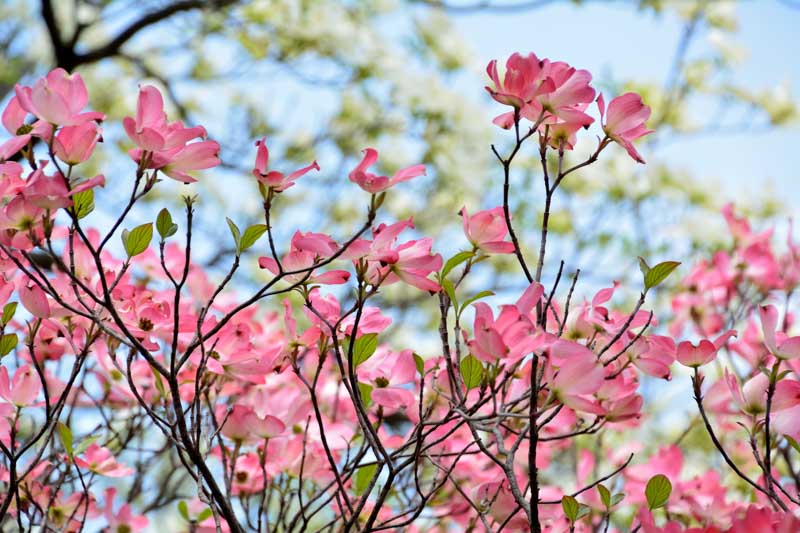
Dogwood Problems: Symptoms, Causes, and Treatments
Dogwoods are beautiful, ornamental trees that are a popular choice for many gardens. However, they can be susceptible to a variety of problems. Below are the most common problems you might encounter, sorted by the type of problem affecting various parts of the tree.
Leaves
White Coating on Leaves
- Symptoms: White film covering the upper and lower surfaces of leaves.
- Causes: Often caused by powdery mildew.
- Treatment: Apply a fungicide designed for powdery mildew; ensure proper air circulation.
Yellowing Leaves
- Symptoms: Leaves turn yellow and may drop prematurely.
- Causes:
- Nitrogen Deficiency: The older leaves will turn a pale green or yellow because plants will transport the available nitrogen to the younger leaves.
- Iron Deficiency: This usually affects the youngest leaves first, making them yellow while leaving the veins green.
- Overwatering: Soggy soil can suffocate the roots, making it difficult for them to absorb nutrients.
- Underwatering: Too little water will also cause yellowing as the plant is stressed.
- Powdery Mildew: While more commonly white, it can also lead to yellowing.
- Scale Insects: Symptoms include yellowing leaves, reduced growth, and a sticky substance known as “honeydew,” which may also attract ants and sooty mold.
- Temperature Fluctuations: Extreme hot or cold can stress the plant and cause yellowing.
- Improper Sunlight: Too much direct sun can cause the leaves to scorch and turn yellow.
- pH Levels: Unsuitable pH levels in the soil can affect nutrient absorption, leading to yellow leaves.
- Treatment: Once the cause is identified, appropriate measures can be taken to remedy the issue.
Brown Spots on Leaves
- Causes:
- Dogwood Anthracnose: Tan spots with irregular purple margins on leaves. Entire leaves may become blighted, turning brown, and eventually falling off prematurely. This is one of the most common diseases to affect dogwoods.
- Cercospora Leaf Spot: Small, tan to light brown spots with reddish-purple borders on leaves. A chlorotic halo might surround spots. Premature leaf drop.
- Septoria Leaf Spot: Brown spots with gray centers on leaves.
- Spot Anthracnose: Small, purple to reddish-brown spots with lighter tan centers on the leaves and flower bracts.
- Drought Stress: Underwatering can cause leaves to develop brown spots.
- Treatment: Once the cause is identified, you can proceed with appropriate treatment, which may include altering care routines, applying specific treatments, or isolating the plant to prevent the spread of contagious diseases. For more severe or mysterious cases, consultation with an arborist or plant pathologist may be helpful.
Leaf Scorch
- Symptoms: Brown or dark red discoloration along the edges and tips of leaves. In severe cases, the entire leaf may dry out and drop off.
- Causes:
- High Temperatures and Sunlight: Excessive heat and sunlight can cause the leaf edges to dry out and turn brown.
- Wind Exposure: Strong winds can accelerate water loss from leaves, causing scorch symptoms.
- Water Stress: Both overwatering and underwatering can lead to leaf scorch, as roots become less effective at supplying water and nutrients.
- Salt Stress: Salts from fertilizers or ice-melting products can accumulate in the soil, leading to leaf scorch.
- Nutrient Imbalance: Excessive fertilization can also lead to salt buildup and consequently cause leaf scorch.
- Treatment: Reduce fertilization and water deeply during hot weather.
Leaves Eaten or Chewed
- Symptoms: Larvae feed voraciously on the leaves, often skeletonizing them by consuming the leaf tissue between the veins. In severe infestations, larvae can defoliate entire branches or even whole trees.
- Causes: Dogwood Sawfly
- Treatment: Manual removal, insecticidal soap. Encouraging birds and beneficial insects (ants, predatory wasps), can help naturally control sawfly populations. Keep the area around your trees clean and free of debris.
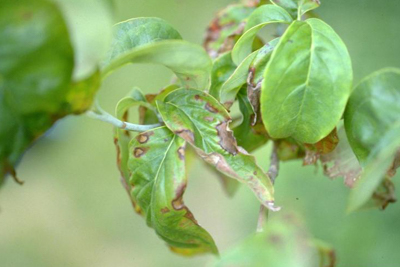 Dogwood Anthracnose Dogwood Anthracnose |
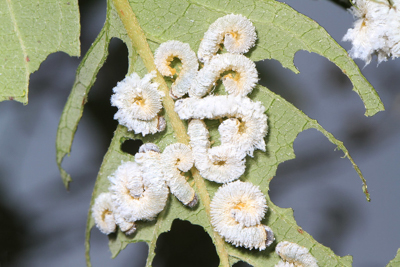 Dogwood Sawfly Dogwood Sawfly |
Flowers
Flower Blight
- Symptoms: Flowers turn brown and wilt. Grayish-brown mold may develop on flowers, leaves, and shoots. The affected flowers eventually dry up and may remain attached to the tree.
- Causes: Botrytis Blight.
- Treatment: Remove any dead or infected leaves, flowers, and stems. Improve air circulation. Fungicide to be used as a last resort.
Poor Flowering
- Symptoms: Few or no flowers.
- Causes:
- Inadequate Light: Dogwoods generally require partial to full sun for optimal flowering. Too much shade can reduce blooming.
- Improper Soil: Dogwoods prefer well-drained, slightly acidic to neutral soil. Poor soil conditions can lead to reduced flowering.
- Extreme Temperatures: Very hot or very cold weather can affect the blooming cycle.
- Water Stress: Both too much and too little water can be detrimental to flowering.
- Nutrient Imbalance: Excessive nitrogen can lead to lush foliage at the expense of blooms. A balanced fertilizer is generally more appropriate.
- Lack of Key Nutrients: Deficiencies in phosphorus or potassium, nutrients that are essential for flowering, can also affect blooming.
- Young Trees: Newly planted or young dogwoods may not flower until they are mature enough, usually around 4 to 7 years of age.
- Old Trees: Extremely old trees may lose their vigor and ability to flower as profusely as they once did.
- Improper Pruning: Dogwoods should generally be pruned shortly after flowering to avoid cutting off next year’s flower buds.
- Last Season’s Stress: If the tree was stressed due to environmental conditions in the previous year, it might produce fewer flowers in the current year.
- Treatment: Ensure full sun exposure and proper soil conditions; prune at the right time.
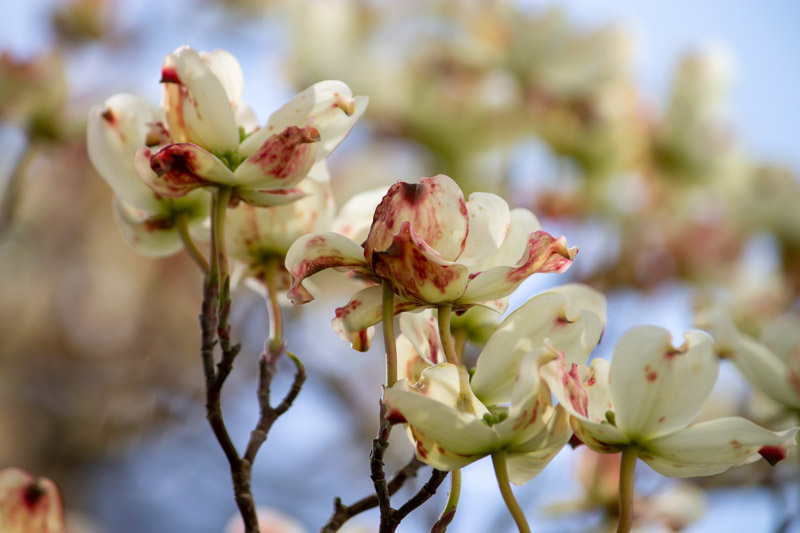 Spot Anthracnose
Spot Anthracnose
Twigs and Branches
Twig Dieback
- Causes:
- Canker Diseases: Sunken, discolored areas on twigs. Various types of canker diseases can cause localized dead areas on twigs and branches, eventually leading to dieback.
- Dogwood Twig Borer: This insect can burrow into the bark and disrupt nutrient and water flow, causing twig dieback.
- Dogwood Clubgall Midge: Abnormal swellings, or galls, on the leaves and stems of dogwood trees. Twigs may die prematurely.
- Scale Insects: These pests can suck the sap out of twigs, weakening them and causing dieback.
- Drought: Lack of water can weaken the tree, making it more susceptible to diseases and pests that can cause twig dieback.
- Water-Logging: Poorly drained soil can also stress the tree and contribute to dieback.
- Temperature Extremes: Extremely hot or cold temperatures can cause twig dieback, especially in younger or stressed trees.
- Nutrient Imbalances: Poor soil fertility can weaken the tree and contribute to dieback.
- Treatment: If you notice twig dieback on your dogwood tree, it’s crucial to accurately diagnose the problem for effective treatment. This might involve a close examination of the tree, soil testing, and possibly consultation with an arborist or plant pathologist for a more in-depth diagnosis and treatment plan.
Branch Dieback
- Causes:
- Dogwood Anthracnose: Initially, you may see tan to brown spots with purple edges on leaves. Affected leaves may fall prematurely. The disease can spread to the twigs, causing young shoots to die back. As the disease progresses, larger branches may die back, starting usually at the tips.
- Canker Diseases: Sunken, discolored areas on twigs. Peeling, cracked bark near the base of the tree.
- Dogwood Borer: Wilted leaves, dying branches, sloughing or shedding of loose bark, holes in the bark.
- Scale Insects: These suck sap from branches, weakening them and potentially causing dieback.
- Water-Logging: Saturated soils can also stress the tree, leading to root rot and branch dieback.
- Temperature Extremes: Very hot or cold weather can damage tissues, leading to dieback, particularly in younger or stressed trees.
- Nutrient Imbalances: Poor soil conditions can stress the tree, contributing to weakened branches and dieback.
- Treatment: If you’re experiencing branch dieback on a dogwood tree, it’s advisable to determine the root cause as accurately as possible for effective treatment.
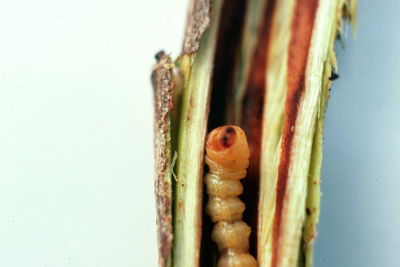 Dogwood twig borer Dogwood twig borer |
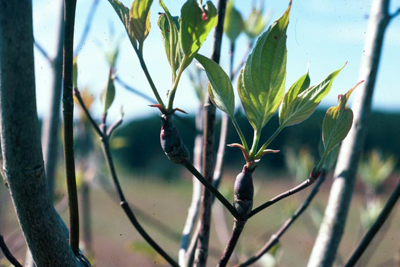 Dogwood Clubgall Midge Dogwood Clubgall Midge |
Bark
Peeling Bark
- Symptoms: Bark peeling or flaking off.
- Causes:
- Maturation: Some dogwood species naturally shed old bark to make way for new growth. This is particularly true for species like the Kousa dogwood (Cornus kousa), which often has exfoliating bark as it matures.
- Canker Diseases: Caused by various fungi, these localized dead areas on the trunk can disrupt nutrient and water flow, leading to peeling bark.
- Drought Stress: Lack of sufficient water can cause the tree to become stressed, leading to bark issues.
- Temperature Fluctuations: Sudden temperature changes, particularly in winter, can cause the bark to crack and peel.
- Over-Mulching: Mulch piled too high against the trunk can create conditions for rot and may result in peeling bark.
- Treatment: If you notice peeling bark on your dogwood tree and are concerned about its health, it’s a good idea to consult a qualified arborist for a proper diagnosis and treatment plan.
Discolored Bark
- Symptoms: Darkening or discoloration of the bark.
- Causes:
- Dogwood Anthracnose: This disease primarily affects leaves but can also spread to the trunk and cause cankers or discolored areas on the bark.
- Canker Diseases: Various fungi cause canker diseases that lead to discolored, sunken patches on the bark.
- Flatheaded Appletree Borers: Sunken, discolored patches on the bark or oozing sap may indicate an infestation.
- Sunscald: This occurs when the bark heats up in direct sunlight and then freezes during the night, leading to discoloration and cracking.
- Temperature Fluctuations: Sudden swings in temperature can stress the tree and cause the bark to crack or discolor.
- Mechanical Injury: This can be from lawnmowers, animals, or accidents, and it may result in discolored areas where the tree is trying to heal itself.
- Poor Drainage: Waterlogged soils can lead to root diseases, which may manifest as bark discoloration.
- Treatment: If you notice discolored bark on your dogwood tree, it may be best to consult a qualified arborist for diagnosis and treatment options.
Chewed Holes in Bark
- Cause: Dogwood Borer
- Treatment: Insecticides. Avoid wounding, such as from lawnmowers. Proper cultural practices to maintain tree health. Cutting away dead or severely infested branches can limit the borer’s spread.
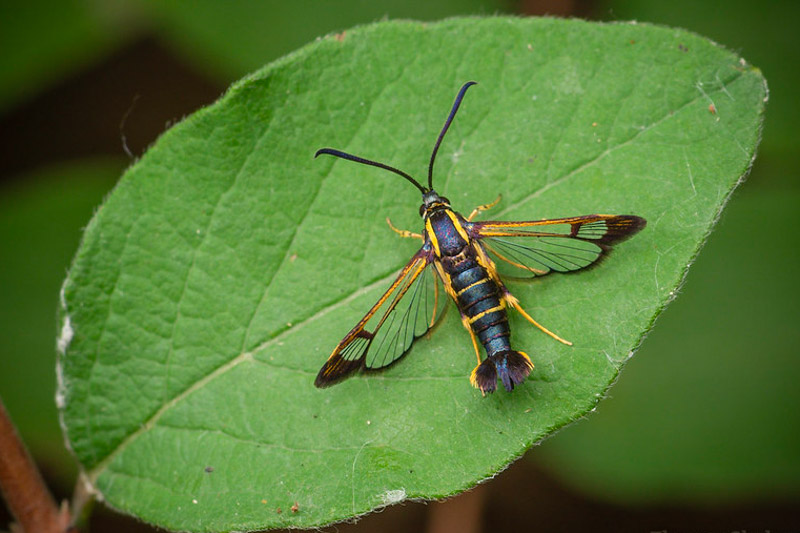 Dogwood Borer
Dogwood Borer
Trunk
Cankers
- Symptoms: Sunken, dead areas on the trunk. Cankers on the trunk of a dogwood tree can be a symptom of various diseases or the result of environmental stressors and physical damage.
- Causes:
- Dogwood Anthracnose: Caused by the fungus Discula destructiva, this disease primarily affects leaves but can also form cankers on younger stems and occasionally on the trunk.
- Nectria Canker: This is caused by fungi in the genus Nectria and typically forms small, round cankers that may ooze sap.
- Botryosphaeria Canker: This fungal disease can infect stressed trees and form large, discolored cankers on the trunk.
- Physical Injury: Wounds from lawnmowers, animals, or accidents can be entry points for canker-causing pathogens.
- Improper Pruning: Badly done pruning cuts can become infected, leading to cankers.
- Treatment: If you notice cankers on the trunk of your dogwood tree, prompt diagnosis and management are essential. Depending on the cause, treatment may involve pruning out the affected areas, applying fungicides, improving soil conditions, or managing environmental stressors.
Splitting Trunk
- Symptoms: Cracks or splits in the trunk. A splitting trunk in a dogwood tree is usually a sign of significant stress or damage.
- Causes:
- Sunscald: During winter, the trunk can warm up in the sunlight and then quickly freeze again, causing the bark to crack or split.
- Frost Cracks: Sudden cold temperatures can cause the trunk to split.
- Drought: Lack of water can make the wood brittle, leading to splits or cracks.
- Mowing and Trimming: Accidental damage from mowing or trimming activities can weaken the trunk and cause it to split.
- Animal Damage: Animals like deer can cause physical damage that leads to splitting.
- Fungal Diseases: Some fungi can weaken the trunk, making it more susceptible to splitting.
- Insect Borers: Insects like the Dogwood Borer can weaken the trunk, contributing to its susceptibility to splitting.
- Old Age: Older trees are generally more susceptible to splitting due to weakened structural integrity.
- Treatment: If you notice a split trunk in your dogwood tree, it’s crucial to consult with a qualified arborist as soon as possible. Depending on the severity and cause of the split, the tree might be salvageable through proper care and management, such as bracing or pruning. However, in severe cases, the tree may need to be removed to prevent it from becoming a safety hazard.
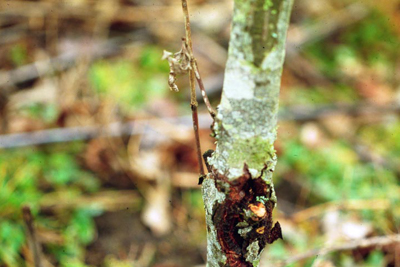 Dogwood Anthracnose Canker Dogwood Anthracnose Canker |
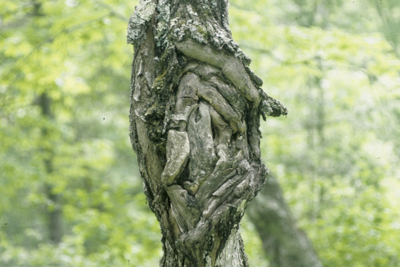 Nectria Canker Nectria Canker |
Roots
Root Rot
- Symptoms: Wilting and yellowing leaves. Cankers near the soil line. Reduced vigor and growth. Dieback of branches. Premature leaf drop.
- Causes:
- Phytophthora Root Rot: Yellowing leaves, wilting, reduced growth and branch dieback are common symptoms of Phytophthora Root Rot. The disease often causes cankers near the soil line and may result in premature leaf drop and tree death.
- Armillaria Root Rot: Also known as honey fungus, it causes yellowing of the leaves, reduced growth, wilting, and early leaf drop. Presence of honey-colored mushrooms that often sprout from the base of infected trees.
- Poor Drainage: Waterlogged soil is the main environmental condition that contributes to root rot.
- Overwatering: Excessive irrigation can exacerbate drainage problems, creating an environment where fungi can thrive.
- Soil Compaction: Compacted soil can reduce drainage, making the tree more susceptible to root rot.
- Planting Depth: Trees planted too deeply can be more susceptible to root rot.
- Mulching: Incorrect mulching techniques, such as piling mulch against the trunk, can create conditions conducive to root rot.
- Treatment:
- Improve Drainage: Planting the tree in well-drained soil or elevating the planting bed can help prevent root rot.
- Water Wisely: Overwatering should be avoided, and irrigation should be applied in a way that allows the soil to dry out between waterings.
- Fungicides: Chemical treatments can sometimes help, but they are often not effective once the disease is advanced.
- Remove Affected Trees: In severe cases, it may be necessary to remove the affected tree to prevent the spread of the disease.
Girdling Roots
- Symptoms: Girdling roots are roots that wrap around the base of the tree’s trunk instead of growing outward. Over time, they can choke the tree by blocking the flow of water and nutrients, which can lead to various health problems for the dogwood. Symptoms of girdling roots in dogwood trees include reduced growth, yellowing and wilting leaves, dieback, premature leaf drop, thin canopy.
- Causes:
- Planting Depth: If a dogwood is planted too deeply or too shallowly, it can encourage girdling roots.
- Poor Planting Practices: Container-grown trees can develop circling roots that eventually become girdling roots if not corrected at planting time.
- Soil Compaction: Hard soil can make it difficult for roots to expand outward, causing them to turn and grow around the trunk.
- Piling mulch against the trunk:
- Treatment:
- Diagnosis: First, you’ll need to expose the root flare at the base of the tree to inspect for girdling roots.
- Root Pruning: Careful pruning can remove girdling roots, but this should be done by a qualified arborist to avoid further damage.
- Soil Aeration: Loosening compacted soil can help roots grow more freely.
- Correct Planting: For new plantings, make sure to plant at the proper depth and spread the roots out in the hole.
- Mulching: Proper mulching can help improve soil quality and reduce competition from grass and weeds, making it less likely for girdling roots to form.
- Monitoring: Regular check-ups can catch girdling roots before they become a severe problem.
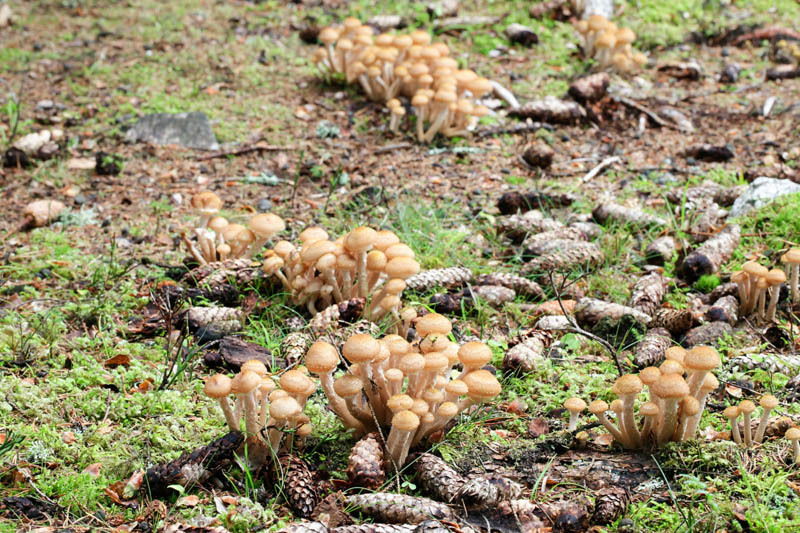 Armillaria Root Rot
Armillaria Root Rot
These are general guidelines and it’s crucial to consult experts for diagnosis and treatment for specific cases.
While every effort has been made to describe these plants accurately, please keep in mind that height, bloom time, and color may differ in various climates. The description of these plants has been written based on numerous outside resources.

 Dogwood Anthracnose
Dogwood Anthracnose Dogwood Sawfly
Dogwood Sawfly Spot Anthracnose
Spot Anthracnose Dogwood twig borer
Dogwood twig borer Dogwood Clubgall Midge
Dogwood Clubgall Midge Dogwood Borer
Dogwood Borer Dogwood Anthracnose Canker
Dogwood Anthracnose Canker Nectria Canker
Nectria Canker Armillaria Root Rot
Armillaria Root Rot